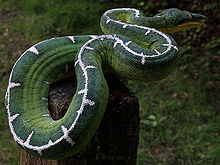
The Boidae, commonly known as boas or boids, are a family of nonvenomous snakes primarily found in the Americas, as well as Africa, Europe, Asia, and some Pacific islands. Boas include some of the world's largest snakes, with the green anaconda of South America being the heaviest and second-longest snake known; in general, adults are medium to large in size, with females usually larger than the males. Six subfamilies comprising 15 genera and 54 species are currently recognized.

Boa is a genus of boas found in Mexico, the Caribbean, and Central and South America. Five extant species, and one extinct, are currently recognized.

Chilabothrus exsul, the Abaco Island boa or Northern Bahamas boa, is a boa species found in the Bahamas. No subspecies are currently recognized. Like all other boas, it is not venomous.

Corallus, the neotropical tree boas, are a genus of boas found in Central America, South America and the West Indies. Nine extant species are recognized as of 2017.

The green tree python, is a species of snake in the family Pythonidae. The species is native to New Guinea, some islands in Indonesia, and the Cape York Peninsula in Australia. First described by Hermann Schlegel in 1872, it was known for many years as Chondropython viridis. As its common name suggests, it is a bright green snake that can reach a total length of 2 m (6.6 ft) and a weight of 1.6 kg (3.5 lb), with females slightly larger and heavier than males. Living generally in trees, the green tree python mainly hunts and eats small reptiles and mammals. It is a popular pet, and numbers in the wild have suffered with large-scale smuggling of wild-caught green tree pythons in Indonesia. Despite this, the green tree python is rated as least concern on the IUCN Red List of endangered species.
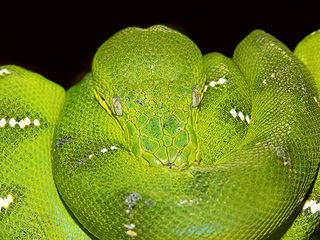
The emerald tree boa is a boa species found in the rainforests of South America. Since 2009 the species Corallus batesii has been distinguished from the emerald tree boa. Like all other boas, it is nonvenomous.

Corallus hortulana, previously known as Corallus hortulanus, and commonly known as the Amazon tree boa, common tree boa, garden tree boa, and macabrel, is a boa species found in South America. Previously, there were two recognized subspecies, Corallus hortulanus hortulanus, and Corallus hortulanus cooki, though the species has undergone taxonomic revision and has been broken up into several species. It is primarily nocturnal and arboreal, though it has been observed feeding and reproducing on the ground. Like all boas, it is non-venomous.

Eryx johnii is a species of nonvenomous snake in the subfamily Erycinae of the family Boidae. The species is native to Iran, Pakistan, and India. There are no subspecies which are recognized as being valid.

Eryx whitakeri, also commonly known as Whitaker's sand boa or Whitaker's boa, is a species of nonvenomous snake in the subfamily Erycinae of the family Boidae. The species is endemic to India. No subspecies are recognized.

Sanzinia madagascariensis, also known as the Madagascar tree boa or Malagasy tree boa, is a boa species endemic to the island of Madagascar. It was once considered conspecific with the Nosy Komba ground boa. Like all other boas, it is non-venomous.

Corallus grenadensis, also known as the Grenada tree boa or Grenada Bank tree boa, is a boa species found in Grenada. No subspecies are currently recognized. Like all other boas, it is not venomous.

Corallus cropanii, or Cropani's tree boa, is a species of boa, a snake in the family Boidae. The species is endemic to the state of São Paulo, Brazil. Like all boas, it is not venomous. No subspecies are currently recognized. Until 2017, no specimen of this snake had been seen alive since 1953 and only five dead specimens had been collected since then, but in late January 2017, an adult female Cropan's tree boa measuring 1.7 m was captured by locals in Ribeira who brought it to herpetologists from the Instituto Butantan and the Museum of Zoology of the University of São Paulo, who radio-tagged and released the animal to learn more about the species' behavior.

Corallus cookii, also known as Cook's tree boa or Cooke's tree boa, is a species of nonvenomous snake in the family Boidae. The species is endemic to the island of St. Vincent in the Caribbean. There are no recognized subspecies.

Corallus ruschenbergerii, commonly known as the Central American tree boa, common tree boa, and Trinidad tree boa, is a boa species found in lower Central America and northern South America. No subspecies are currently recognized. Like all boas, it is not venomous.

The Cuban boa, also known as the Cuban tree boa and by locals as Majá de Santa María, is a very large species of snake in the family Boidae. With lengths exceeding 5 m (16 ft) and a relatively heavy build, the Cuban boa is one of the largest snakes in North America. The species is native to Cuba and some nearby islands. No subspecies are currently recognized.

Chilabothrus, commonly known as the Greater Antillean boas or West Indian boas, is a genus of nonvenomous snakes the family Boidae. The genus is endemic to the West Indies. 12 or 14 species are recognized as being valid.
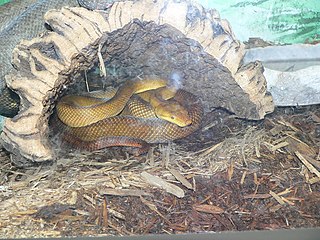
Candoia bibroni—commonly known as Bibron's bevel-nosed boa, Bibron's keel-scaled boa, the Pacific tree boa or the Fiji boa—is a species of boa, a group of non-venomous, constricting snakes, endemic to the southern Pacific Ocean island chains of Melanesia and Polynesia. Two subspecies are recognized, including the nominate subspecies, described here. Candoia bibroni is one of the most isolated and far-removed species of boid snakes on earth, as the majority of boa species are found in the Americas and the Caribbean, or, in the case of the terrestrial sand boas, in Africa and Eurasia.
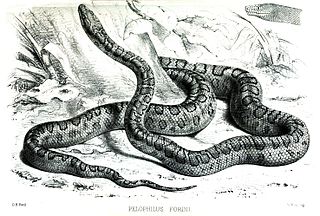
Chilabothrus fordii, also known commonly as Ford's boa and the Haitian ground boa, is a species of snake in the family Boidae. There are three recognized subspecies.
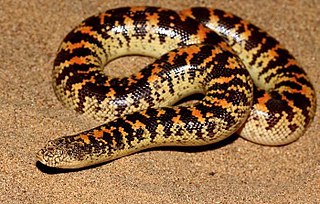
Eryx jayakari, known commonly as the Arabian sand boa or Jayakar's sand boa, is a species of snake in the family Boidae. The species is endemic to the Arabian Peninsula and Iran where it spends the day buried in the sand.
